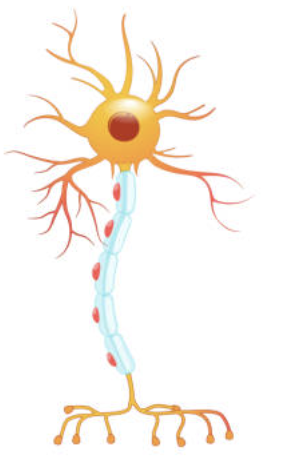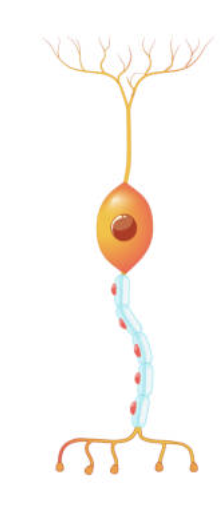Stage 2 Biology - Homeostasis
1/28
Earn XP
Description and Tags
Name | Mastery | Learn | Test | Matching | Spaced |
|---|
No study sessions yet.
29 Terms
Explain the role of a neurotransmitter
A neurotransmitter is a chemcial release from the presynaptic neuron into the synapse via exocytosis. The neurotransmitter then binds to receptors on the postsynaptic neuron, sending an electrical impulse along the neuron, to transmit messages between neurons.
Where are motor neurons located
PNS
Where are inter neurons located
CNS
Where are sensory neurons located
PNS
Explain the stimulus response model
A stimulus is detected from either the internal or external environment. The stimuli is detected by sensory receptors which then signals to a sensory neuron. The sensory neuron then transmits the message to an inter neuron and then the inter neuron to the motor neuron. The motor neuron then signals an effector, triggering a response.
Describe the role of synapses
Synapses is a gap between neurons that allows for neurotransmitters to be transported between neurons
Describe negative feedback
Negative feedback is when an initial stimulus is reduced or inhibited by a response.

State the type of neuron and its role
This is a motor neuron and it transmits messages from the CNS to the effector

State the type of neuron
This is a sensory neuron and it transmits information from a receptor to the CNS

State the type of neuron
This is an inter neuron, it is located in the CNS and transmits information from sensory neurons to motor neurons
State the role of sensory receptors
Sensory receptors detect stimuli
State the role of effectors
Causes a response to the stimulus
Explain the effect of an increase of insulin has on the body
Insulin is released by the pancreas and binds to cells in the liver, triggering the uptake of glucose from the bloodstream and storing it as glycogen which results in an decrease of blood glucose.
Explain the effect of an increase of glucagon on the body
Glucagon is released by the pancreas and binds to cells in the liver triggering the breakdown of glycogen into glucose therefore raising glucose levels.
Explain the effect of ADH on the kidneys and osmoregulation
ADH binds to cells in the nephron, triggering an increase of aquaporins on the cells in the collecting tubule. This increases the reabsorption of H2O back into the blood stream, lowering blood osmolarity. An increase of ADH causes high urine osmolarity because H2O is transported from urine to the blood stream.
Describe the role of adrenaline in the context of the ‘fight or flight’ response
The hypothalamus detects stress and then sends an electrical impulse to the adrenal gland. The adrenal gland then releases adrenaline into the bloodstream, resulting in physiological changes that prepare the body for the 'fight or flight' response. Adrenaline increases heart rate, dilates pupils, dilates airways and increases respiration rate. These changes increases oxygen availability around the body and increases alternates.
State the stimulus and reflex response model
Sensory receptor, sensory neuron, inter neuron, motor neuron, effector, response
State the difference between the reflex response and stimulus response models
In the reflex response the electrical impulse is sent to the spinal cord, in a stimulus response the electrical impulse is sent to the spinal cord and travels up to the brain for processing
Explain the response to high blood osmolarity
Low blood H2O is detected in the hypothalamus, which releases ADH into the bloodstream. ADH binds to cells in the nephron, triggering an increase of aquaporins on the cells of the collecting tubule. This increases the reabsorption of water back into the bloodstream, lowing blood osmolarity.
Explain the response to low osmolarity
High blood H2O is detected by the hypothalamus which decreases ADH. This results in less ADH binding to cells on the nephron and therefore less aquaporins are present ont the cells of the collecting tubule. This decreases reabsorption of water back into the blood stream
Explain the body’s response to high blood glucose levels
High glucose levels are detected by cells in the pancreas. Beta cells in the pancreas then release insulin into the bloodstream. Insulin bonds to cells in the liver which increases the uptake of glucose from the bloodstream and stores it as glucagon, reducing blood glucose levels.
Explain the body’s response to low bloods glucose levels
Low blood glucose is detected by cells in the pancreas. Alpha cells in the pancreas then release glucagon into the bloodstream and stores stream. Glucagon then binds to cells in the liver, breaking down glycogen into glucose so that it can be released into the bloodstream. This increases blood glucose levels.
Explain the the endocrine response to high body temperature
High body temperature is detected by thermoreceptors in the hypothalamus. The hypothalamus then sends a messages to the pituitary gland which decreases TSH secretion. Therefore the thyroid is stimulated less, resulting in less thyroxine released. This decreases metabolic rate, leading to a decreased rate of respiration and therefore less heat energy is released, causing a decrease in body temperature.
Explain the endocrine response to low body temperature
Low body temperature is detected by thermoreceptors in the hypothalamus. The hypothalamus then sends an electrical impulse to the pituitary gland, which releases TSH. TSH stimulates the activation of the thyroid which releases thyroxine into the bloodstream. Thyroxine targets cells in the body, speeding up the metabolic rate and as a result generates more heat energy, increasing body temperature.
Explain 2 nervous responses to high body temperature
High body temperature is detected by thermoreceptors in the hypothalamus. The hypothalamus sends an electrical impulse to the sweat glands, causing to secrete sweat, which would evaporate of the skin, providing a cooling effect and resulting in heat loss.
The hypothalamus sends an electrical impulse is sent to the capillaries, causing them to dilate, increasing blood flow and the distance between the blood vessel and skin, losing heat more readily.
Explain 2 nervous responses to low body temperature
Low body temperature is detected by thermoreceptors in the hypothalamus. The hypothalamus then sends an electrical impulse to the muscle fibres, which causes them to contract and relax rapidly, generating heat and increasing body temperature.
Low body temperature is detected by thermoreceptors in the hypothalamus. The hypothalamus then sends an electrical impulse to the blood vessels causing them to constrict, preventing heat loss and retaining body heat.
Explain the body’s response to high CO2
CO2 builds up in the blood. CO2 them crosses the blood brain barrier and reacts with water to form carbonic acid (H2CO3). The carbonic acid then breaks downs into hydrogen carbonate (HVO3) and hhydrogen ions (H+). The hydrogen ions are then detected by chemoreceptors in the medulla oblongata, indicating a high pH level. A nerve impulse is then sent to respiratory organs to increase breathing rate, resulting in an increased and more expelling CO2, increasing blood pH.
steroid vs non-steroid communication
Steroid hormones are lipid soluble and can therefore pass through a cell membrane and bind to receptors inside a cell. Non-steroid hormones are not lipid soluble and therefore binds to receptors on the membrane.
Compare charateristics of the action of the nervous and endocrine system.